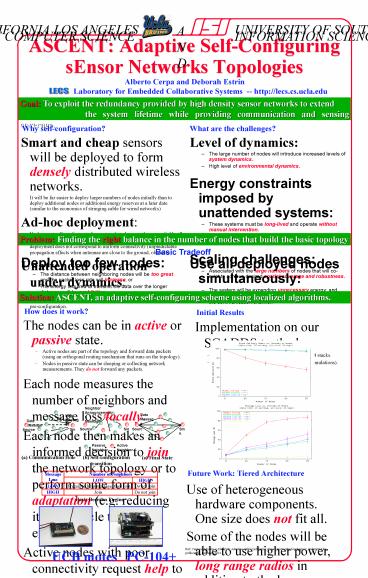ASCENT: Adaptive SelfConfiguring sEnsor Networks Topologies - PowerPoint PPT Presentation
1 / 1
Title:
ASCENT: Adaptive SelfConfiguring sEnsor Networks Topologies
Description:
... the sensor field will not be deployed in a regular fashion. ... Additional research issues: Interaction between ASCENT and data dissemination protocols. ... – PowerPoint PPT presentation
Number of Views:59
Avg rating:3.0/5.0
Title: ASCENT: Adaptive SelfConfiguring sEnsor Networks Topologies
1
ASCENT Adaptive Self-Configuring sEnsor Networks
Topologies
AND
Alberto Cerpa and Deborah Estrin Laboratory for
Embedded Collaborative Systems --
http//lecs.cs.ucla.edu
- LECS
Goal To exploit the redundancy provided by high
density sensor networks to extend the
system lifetime while providing communication and
sensing coverage.
Why self-configuration?
What are the challenges?
- Smart and cheap sensors will be deployed to form
densely distributed wireless networks. - It will be far easier to deploy larger numbers
of nodes initially than to deploy additional
nodes or additional energy reserves at a later
date (similar to the economics of stringing cable
for wired networks) - Ad-hoc deployment
- Nodes must self-configure to form a topology
because the sensor field will not be deployed in
a regular fashion. More importantly, uniform
deployment does not correspond to uniform
connectivity (unpredictable propagation effects
when antennae are close to the ground, obstacles) - Unattended operation under dynamics
- The large number of elements in these systems
will preclude manual configuration, and the
environmental dynamics will preclude design-time
pre-configuration.
- Level of dynamics
- The large number of nodes will introduce
increased levels of system dynamics. - High level of environmental dynamics.
- Energy constraints imposed by unattended systems
- These systems must be long-lived and operate
without manual intervention. - The system must execute the measurements and
adaptive configuration in an energy constrained
fashion - Scaling challenges
- Associated with the large numbers of nodes that
will co-exist to achieve desired spatial coverage
and robustness.
Problem Finding the right balance in the number
of nodes that build the basic topology
Basic Tradeoff
- Deploy too few nodes
- The distance between neighboring nodes will be
too great and the packet loss rate will increase
or - The energy required to transmit the data over the
longer distances will be prohibitive.
- Use all deployed nodes simultaneously
- The system will be expending unnecessary energy
and - The nodes may interfere with one another by
congesting the communication channel.
Solution ASCENT, an adaptive self-configuring
scheme using localized algorithms.
How does it work?
Initial Results
- The nodes can be in active or passive state.
- Active nodes are part of the topology and forward
data packets (using an orthogonal routing
mechanism that runs on the topology). - Nodes in passive state can be sleeping or
collecting network measurements. They do not
forward any packets. - Each node measures the number of neighbors and
message loss locally. - Each node then makes an informed decision to join
the network topology or to perform some form of
adaptation (e.g. reducing its duty cycle to save
energy). - Active nodes with poor connectivity request help
to other passive neighbor in the vicinity to
improve coverage.
- Implementation on our SCADDS testbed
- Low-power Radiometrix RPC radio and PC104
stacks. - Run real experiments with up to 30 nodes (not
simulations).
Future Work Tiered Architecture
- Use of heterogeneous hardware components. One
size does not fit all. - Some of the nodes will be able to use higher
power, long range radios in addition to the low
power, short range ones. - Develop self-configuring algorithms that could
detect and fix network partitions of the short
range radio topology. - Additional research issues
- Interaction between ASCENT and data dissemination
protocols. - Relation between simulation and real experiments.
Ref Cerpa and Estrin, ASCENT Adaptive
Self-Configuring sEnsor Networks Topologies,
Submitted for publication, February 2001.































